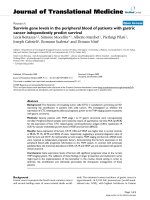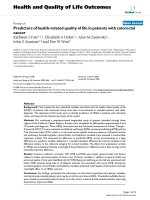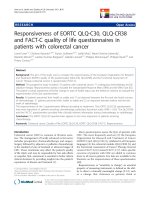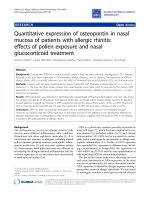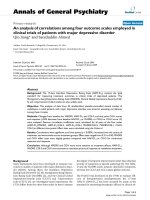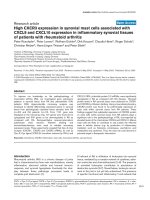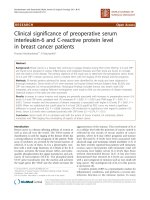Expression and clinical significance of miR4516 and miR-21-5p in serum of patients with colorectal cancer
Bạn đang xem bản rút gọn của tài liệu. Xem và tải ngay bản đầy đủ của tài liệu tại đây (900.03 KB, 7 trang )
Jin et al. BMC Cancer
(2020) 20:241
/>
RESEARCH ARTICLE
Open Access
Expression and clinical significance of miR4516 and miR-21-5p in serum of patients
with colorectal cancer
Xi-Han Jin1, Sen Lu2 and Ai-Fen Wang3*
Abstract
Background: This study sought to detect the expression and clinical significance of miR-4516 and miR-21-5p in
serum of patients with colorectal cancer.
Methods: Bioinformatics methods were used to analyze the expression patterns of miR-4516 and miR-21-5p in
colorectal cancer. A total of 80 patients with colorectal cancer, 65 patients with benign colorectal tumors and 50
healthy persons were selected. qRT-PCR was performed to detect the expression levels of serum miR-4516 and miR21-5p before and after operation or postoperative recurrence. The correlation of miR-4516 and miR-21-5p
expression levels with the clinical characteristics and prognosis of colorectal cancer was analyzed, and that with the
patient’s survival was further examined by Kaplan-Meier analysis.
Results: MiR-4516 was poorly expressed in colorectal cancer in the preoperative group, and miR-21-5p was highly
expressed. While in the postoperative group, miR-4516 was up-regulated, and miR-21-5p was down-regulated. The
low expression of miR-4516 was shown to be related to TNM staging, invasion degree, lymph node metastasis and
distant metastasis of the patients. Whereas the high expression of miR-21-5p was proved to be correlated with TNM
staging and lymph node metastasis. Kaplan-Meier survival analysis showed that high expression of miR-4516 or low
expression of miR-21-5p could contribute to better overall survival.
Conclusion: Low miR-4516 or high miR-21-5p could be used as an independent risk factor for prognosis of
colorectal cancer.
Keywords: Colorectal cancer, miR-4516, miR-21-5p, Serum
Background
Colorectal cancer (CRC) is the third most common malignancy in the world, including colon cancer and rectal
cancer, with the incidence and mortality in China annually increased [1]. Although many factors like environmental factors (such as high-fat diet, intestinal flora
imbalance), genetic factors and inflammatory bowel disease can lead to CRC, about 80% of CRC cases are
* Correspondence:
3
Department of Oncology, The First Hospital of Jiaxing, The First Affiliated
Hospital of Jiaxing University, No. 1882 South Zhonghuan Road, Nanhu
District, Jiaxing 314001, China
Full list of author information is available at the end of the article
developed from colorectal adenoma (CRA). In addition,
despite the great advance in current technology for CRC
treatment, the response on metastatic CRC is still very
poor, which makes the early diagnosis of CRC become
the key for mortality reduction and prognosis improvement [2, 3]. Therefore, the search for a more sensitive,
easy to be detected and representative biomarker is of
great significance for CRC early diagnosis and
monitoring.
MicroRNAs (miRNAs) are evolutionarily conserved,
endogenous and non-coding small RNAs playing a key
role in the regulation of gene expression in key cellular
© The Author(s). 2020 Open Access This article is licensed under a Creative Commons Attribution 4.0 International License,
which permits use, sharing, adaptation, distribution and reproduction in any medium or format, as long as you give
appropriate credit to the original author(s) and the source, provide a link to the Creative Commons licence, and indicate if
changes were made. The images or other third party material in this article are included in the article's Creative Commons
licence, unless indicated otherwise in a credit line to the material. If material is not included in the article's Creative Commons
licence and your intended use is not permitted by statutory regulation or exceeds the permitted use, you will need to obtain
permission directly from the copyright holder. To view a copy of this licence, visit />The Creative Commons Public Domain Dedication waiver ( applies to the
data made available in this article, unless otherwise stated in a credit line to the data.
Jin et al. BMC Cancer
(2020) 20:241
processes [4, 5]. Studies have shown that miRNAs participate in a series of life processes acting as important
regulators during tumorigenesis and development, including
individual
development,
organogenesis,
hematopoiesis, cell proliferation, differentiation and
apoptosis, tumor occurrence, invasion and metastasis [6,
7]. miRNAs are available in a non-invasive manner with
high sensitivity (62 to 89%) and specificity (from 41 to
89%), and they can be used to identify CRC patients with
normal persons [8]. miR-21 is one of the miRNAs found
by human earlier, and it can be highly expressed in many
cancer types, such as pancreatic cancer, breast cancer,
lung cancer, stomach cancer and CRC [9–11]. Meanwhile, miR-21 is involved in the characteristics regulation of tumor phenotypes, like tumor growth, invasion
and metastasis. miR-4516 can promote cell apoptosis
[12], predict the poor prognosis of human glioblastoma
[13], and targeted regulate psoriasis [14], but its role in
CRC has not been studied. Recent studies have shown
that miRNAs are abnormally expressed in peripheral
blood of CRC patients, and they are involved in CRC
progression with the potential serving as biomarkers
[15].
In this study, we detected the expression of miR-21-5p
and miR-4516 in tissues and serum of patients with
CRC, CRA and healthy persons, analyzed the relationship between their expression levels and clinicopathological characteristics, and explored the value of miRNAs in
serum in the early diagnosis of CRC.
Page 2 of 7
50 cases who made physical examination in our hospital were selected as healthy control group (Normal
group), including 28 males and 22 females aged 28 to
72 years with an average of 42.32 (±9.23) years old,
and there were no abnormalities observed by colonoscopy. There were no significant differences in gender,
age and other general data among the three groups
(P > 0.05). Sample and relevant data collection in this
study was approved by the Medical Ethics Committee,
and the relevant informed consent was obtained from
all patients.
Main reagents
Trizol total RNA extraction kit was purchased from
Beijing Aidlab Biotechnologies Co., Ltd.. Fully automatic
electrochemiluminescence immunoassay (Model Number: E2010) was from Roche, Switzerland and high-speed
refrigerated centrifuge was procured from Eppendof,
Germany.
Methods
Specimen collection
6 mL of venous blood were drawn from all enrolled patients with an empty stomach in the morning, respectively, and collected in vacuum blood collection tubes for
30 min at room temperature, then centrifuged at 2500 r/
min for 10 min. The collected serum was stored in a refrigerator at − 80 °C.
Real-time quantitative PCR (qRT-PCR)
Methods
Research object
80 patients who were pathologically diagnosed as
CRC and treated in our hospital from January to October 2016 were selected as CRC group, including 38
males and 42 females aged 29 to 75 years old with an
average of 50.90 (± 9.50) years old. Inclusion criteria:
1. In accordance with the clinical diagnostic criteria
of CRC; 2. Patients newly diagnosed as CRC; 3. Had
not receive any radiotherapy, chemotherapy or biological therapy. Exclusion criteria: 1. With other types
of tumor diseases; 2. Postoperative patients or those
with CRC recurrence; 3. With severe functional diseases like heart, liver, kidney diseases and immune
system diseases; 4. Being treated with other therapies
before surgery; 5. Patients in pregnant; 6. Patients
who did not comply with, and cooperate with the
treatment. Totally 65 patients with colon polyp in our
hospital were selected as benign colorectal tumor
group (CRA group), including 30 males and 25 females aged 30 to 71 years old with an average of
44.45 (± 10.94) years old. They were all pathologically
diagnosed as low-grade intraepithelial neoplasia or
colon hyperplastic polyp after operation. In addition,
Trizol Total RNA Extraction Kit was used to extract the
total RNA from serum. 5 μl of RNA samples were diluted 20 fold with RNase-free ultrapure water, and the
absorbance values at 260 nm and 280 nm were read
using a UV spectrophotometer for the determination of
the RNA concentration and purity. RNA samples with
1.7 ≤ OD260/OD280 ≤ 2.1 were qualified for subsequent
analysis. PCR amplification instrument was used to
synthesize the cDNA template by reverse transcription
reaction, and ABI7500 quantitative PCR instrument was
applied to perform qRT-PCR. The reaction conditions
were pre-denaturation at 95 °C for 10 min, and 35 PCR
cycles (95 °C for 15 s, 60 °C for 1 min). U6 was utilized as
internal reference. The primers used in the reaction
were as follows:
miR-4516
Forward Primer: 5′-CCGCCGACTAGTGCGGAT
CATAAGGTCAGGAG-3′
Reverse Primer: 5′-CCGCCGACGCGTGGCCAG
GACAGCAGCTTA − 3′
miR-21-5p
Forward Primer: 5′-GCCCGCTAGCTTATCAGA
CTGATG-3′
Jin et al. BMC Cancer
(2020) 20:241
Reverse Primer: 5′-GTGCAGGGTCCGAGGT-3′
Detection of serum CEA
Automatic electrochemiluminescence immunoassay was
used for detection the serum CEA. According to the
CEA kit, the diagnostic critical reference value of CEA
was 5 ng/mL.
Follow-up
Postoperative patients of the CRC group came to our
hospital to review the CEA and perform abdominal CT
scan after 0, 6, 12, 18, 21 and 24 months, respectively.
Combined with the clinical symptoms of the patients,
we could determine whether there was local recurrence
or metastasis. Blood samples of patients with recurrence
or metastasis were collected. The follow-up period was
2 years.
Page 3 of 7
Statistical analysis
All data were processed by SPSS 22.0 statistical software.
The measurement data were expressed in the form of
mean value ± standard deviation. The count data were
presented as a ratio or percentage. The comparison of
measurement data was performed by t test, and that of
count data was performed by χ2 test. ROC curve was utilized to analyze the efficacy of indicators in the diagnosis
of each group. Kaplan-Meier survival analysis was used to
analyze the relationship between miR-4516 and miR-215p expression levels and postoperative survival in CRC patients. P < 0.05 was considered statistically significant. P <
0.01 was considered extremely statistically significant.
Results
The expression levels of miR-4516 and miR-21-5p in
serum
The differential expression of miRNAs in colon cancer
was analyzed using the GSE72281 chip in the GEO
Fig. 1 Expression levels of serum miR-4516 and miR-21-5p in CRC. a Cluster thermogram of the differentially expressed miRNAs in CRC detected
via bioinformatics analysis; b miR-4516 expression level tested by qRT-PCR; (C) miR-21-5p expression level examined by qRT-PCR
Jin et al. BMC Cancer
(2020) 20:241
database. As shown in Fig. 1a, miR-4516 was poorly
expressed in colorectal cancer, while miR-21-5p was
highly expressed. Then, qRT-PCR was used to detect the
expression levels of miR-4516 and miR-21-5p in the
serum of the Normal group, CRA group and CRC group.
The results shown in Fig. 1b and Fig. 1c suggested that
miR-4516 was significantly down-regulated (P < 0.05) in
the CRA group and CRC group relative to the Normal
group, whereas miR-21-5p was significantly up-regulated
(P < 0.05).
Postoperative dynamic changes of serum miR-4516 and
miR-21-5p in the CRC Group
After following-up, recurrence occurred in 18 patients
in the CRC group, including local recurrence in 12
cases and distant metastasis in 6 cases. As shown in
Fig. 2, serum miR-4516 in the CRC group was significantly up-regulated after operation while miR-21-5p
was remarkably down-regulated (P < 0.05). There was
no significant difference observed in miR-4516 and
miR-21-5p expression levels between the preoperative
and recurrence groups (P > 0.05).
Relationship between the serum miR-4516 and miR-21-5p
expression levels and Clinicopathological parameters of
CRC
As shown in Table 1, the low expression of miR-4516
was related to TNM staging, invasion degree, lymph
node metastasis and distant metastasis, with statistical
significance (all P < 0.05). While the high expression of
miR-21-5p was shown to be correlated with TNM staging and lymph node metastasis, with statistical significance (both P < 0.05).
Page 4 of 7
ROC analysis of serum miR-4516 and miR-21-5p in CRC
diagnosis
To further evaluate the value of miR-4516 and miR-215p in identifying CRC patients from normal persons, we
performed ROC analysis in 80 CRC patients, and the results were shown in Table 2. The ordinate refers to the
sensitivity and the abscissa refers to the specificity. ROC
curves were made as Fig. 3, and the areas under the
curve (AUC) were shown in Table 2. The AUC values
were tested, and all of them have P < 0.05. When the
Cut-off reached the optimal value, it could be concluded
that the diagnostic efficiency of miR-4516, miR-21-5p,
and the combination of miR-4516 and miR- 21-5p in
CRC were better than that of CEA.
Relationship between the serum miR-4516 and miR-21-5p
and prognosis of CRC patients
Kaplan-Meier survival analysis was performed on the
miR-4516 and miR-21-5p in CRC patients (Fig. 4). The
results revealed that high miR-4516 or low miR-21-5p
could significantly increase the overall survival rate, and
the differences were statistically significant (both P <
0.05).
Discussion
Colon cancer is one of the most common malignancies in the world. The occurrence of colon cancer is
a very complex pathogenic process that is controlled
by multiple genes and formed in different stages over
a long period of time [16–18]. With the development
of molecular biotechnology, miRNAs related to colon
cancer have been discovered one after another. Studies have shown that more miRNAs are discovered to
be present in colon cancer and play an important role
Fig. 2 Dynamic changes of serum miR-4516 and miR-21-5p in CRC. a miR-4516 expression level detected by qRT-PCR; b miR-21-5p expression
level assayed by qRT-PCR
Jin et al. BMC Cancer
(2020) 20:241
Page 5 of 7
Table 1 Relationship between the expression of miRNAs and clinicopathological characteristics of colorectal cancer
N=
80
miR-4516
< 60
43
2.09 (1.89, 2.25)
≥ 60
37
2.08 (1.95, 2.16)
male
38
2.14 (1.95, 2.24)
female
42
2.11 (1.96, 2.27)
< 5 cm
35
2.10 (1.96, 2.26)
≥ 5 cm
45
2.04 (1.95, 2.24)
colon
38
2.12 (1.97, 2.29)
rectum
42
2.15 (1.99, 2.22)
T1,T2
30
1.94 (1.88, 1.98)
T3,T4
50
2.17 (2.07, 2.26)
I-II
44
2.40 (2.20,2.48)
III-IV
36
1.79 (1.74, 1.92)
Group
miR-21-5p
P
Relative Expression Level
[M (P25, P75)]
Relative Expression Level
[M (P25, P75)]
P
1.75 (1.54, 2.01)
0.2768
Age
0.0969
1.83 (1.65, 2.03)
Gender
0.8576
1.74 (1.55, 1.96)
0.1522
1.84 (1.64, 2.04)
Tumor Size
0.7774
1.74 (1.53, 1.94)
0.4806
1.80 (1.62, 1.96)
Tumor Location
0.5136
1.68 (1.53, 1.90)
0.4000
1.78 (1.55, 1.96)
Infiltration Degree
0.0432
1.76 (1.59, 1.92)
0.0758
1.79 (1.54, 1.94)
TNM Stage
< 0.001
2.04 (1.90,2.19)
0.001
1.58 (1.35, 1.64)
Lymph Node Metastasis
non
48
2.33 (2.14, 2.39)
exist
32
1.80 (1.82, 1.90)
non
52
2.37 (2.20, 2.42)
exist
28
1.81 (1.74, 1.89)
<5
41
2.09 (1.97, 2.20)
≥5
39
2.12 (1.99, 2.24)
0.002
2.04 (1.90,2.19)
0.003
1.58 (1.35, 1.64)
Distant Metastasis
0.029
1.64 (1.50, 1.88)
0.301
1.77 (1.58, 1.96)
CEA Level (ng/ml)
0.417
1.88 (1.68, 1.92)
0.064
1.60 (1.59, 1.79)
in the tumorigenesis, development and prognosis. We
used the colon cancer tissue chip GSE72281 in the
GEO database to explore the potential role of miRNAs in colon cancer and found that miR-21-5p and
miR-4516 are differentially expressed in the tissue
chip. In recent years, it has been reported that miR21 has a close relationship with colon cancer, and
acts as a key molecule in EMT development. Besides,
miR-21 overexpression is controlled by both genetic
and epigenetic alterations, and its levels can be used
as a tool for predicting CRC metastasis [9, 11]. However, miR-4516 is found in the serum of esophageal squamous cell carcinoma and differentially expressed [19].
Blood samples are easy to obtain, and the detection of
serum miRNAs for CRC diagnosis and prognosis prediction
is more suitable for clinical application. However, reports
Table 2 Analysis on the expression levels of miR-4516 and miR-21-5p detecting the ROC of colorectal cancer
Variate
Sensitivity (%)
Specificity (%)
AUC
P Value
Cut-off
miR-4516
94.40
89.80
0.9584
< 0.001
2.17
miR-21-5p
90.63
86.20
0.9278
< 0.001
1.53
CEA
85.70
84.90
0.774
< 0.001
1.20
miR-4516 + miR-21-5p
92.11
87.60
0.9425
< 0.001
1.88
Jin et al. BMC Cancer
(2020) 20:241
Page 6 of 7
Fig. 3 ROC analysis of serum miR-4516 and miR-21-5p in CRC
on miR-4516 in colon cancer serum are rare. Therefore, we
used serum samples to explore the significance of miR4516 and miR-21-5p expression and clinical diagnosis of
colorectal cancer patients.
In this study, qRT-PCR was used to detect the expression levels of miR-4516 and miR-21-5p in serum of 80
CRC patients, 65 CRA patients and 50 normal persons.
The results showed that miR-21-5p was highly expressed
in serum of CRC patients, which is consistent with the
literature [11]. Besides, serum miR-4516 and miR-21-5p in
CRC patients changed dynamically after surgery and recurrence, indicating that both miR-4516 and miR-21-5p may
have diagnostic value for CRC. In addition, correlation analysis was conducted and found that miR-4516 was significantly associated with TNM staging, invasion degree,
lymph node metastasis and distant metastasis, whereas
miR-21-5p showed great correlation with only TNM staging and lymph node metastasis, which suggested that both
miR-4516 and miR-21-5p may act as oncogenes responsible
for the CRC progression with diagnostic value. Moreover,
ROC and Kaplan-Meier analyses indicated that miR-4516
and miR-21-5p could be used as an auxiliary diagnostic criterion for judging the CRC prognosis.
As serum is easy, fast to obtain and non-invasive, and
miRNAs in serum are stable, serum miRNAs can be
used as novel biomarkers to assist in the CRC diagnosis
with good clinical significance, which makes early
screening and diagnosis of CRC possible. The alterations
of miR-4516 and miR-21-5p in serum suggest that these
two miRNAs have the potential serving as tumor
markers, and can be used as new therapeutic targets in
CRC treatment.
Fig. 4 Relationship between the serum miR-4516 and miR-21-5pexpression levels and Prognosis of CRC Patients. a Kaplan-Meier curve of miR4516; b Kaplan-Meier curve of miR-21-5p
Jin et al. BMC Cancer
(2020) 20:241
Page 7 of 7
Abbreviations
CRC: Colorectal cancer; CRA: Colorectal adenoma
12.
Acknowledgements
Not applicable.
13.
Authors’ contributions
XHJ contributed to data analysis, drafting the article and gave final approval
of the version to be published. SL and AFW wrote the article and revised it.
All authors agreed to be accountable for all aspects of the work.
14.
Funding
Not applicable.
15.
Availability of data and materials
The data used to support the findings of this study are included within the
article. The data and materials in the current study are available from the
corresponding author on reasonable request.
Ethics approval and consent to participate
This study was conducted in accordance with the Helsinki Declaration II and
was approved by the Institutional Review Boards of the First Hospital of
Jiaxing. Informed consent was obtained from all patients through verbal.
Consent for publication
Not applicable.
Competing interests
The authors declare that they have no competing interests.
Author details
1
Department of Colorectal Surgery, Jinhua Hospital of Zhejiang University,
Jinhua Municipal Central Hospital, Jinhua 321000, China. 2Department of
Colorectal Surgery, The First Affiliated Hospital, College of Medicine, Zhejiang
University, Hangzhou 310003, China. 3Department of Oncology, The First
Hospital of Jiaxing, The First Affiliated Hospital of Jiaxing University, No. 1882
South Zhonghuan Road, Nanhu District, Jiaxing 314001, China.
Received: 29 August 2019 Accepted: 5 March 2020
References
1. Fang Q, Qu A, Zhang X, Du L, Yang Y, Wang C. Expression and clinical
significance of miR-210 in the serum of patients with colorectal cancer. J
Shandong University (Health Sciences). 2015;06:77–81.
2. Chen Z, Huang Z, Jin R. Expression and clinical significance of LRG1in the
serum of patients with colorectal cancer. China Modern Doctor. 2017;26:1–
3.
3. Ebrahimi F, Gopalan V, Wahab R, Lu C-T, Smith RA, Lam AK-Y. Deregulation
of miR-126 expression in colorectal cancer pathogenesis and its clinical
significance. Exp Cell Res. 2015;339(2):333–41.
4. Meister J. Schmidt MHH: miR-126 and miR-126*: new players in cancer.
Scientific World J. 2010;10:2090–100.
5. Moles R. MicroRNAs-based therapy: a novel and promising strategy for
Cancer treatment. Microrna. 2017;6(2):102–9.
6. Wang Y, Taniguchi T. MiRs and DNA damage response: implications for
cancer therapy. Cell Cycle. 2013;12(1):32–42.
7. Wan D, He S, Xie B, Xu G, Gu W, Shen C, Hu Y, Wang X, Zhi Q, Wang L.
Aberrant expression of miR-199a-3p and its clinical significance in colorectal
cancers. Med Oncol. 2013;30(1):378.
8. Sun K, Wang W, J-j Z, Wu C-t, Lei S-t, Li G-x. MicroRNA-221 inhibits CDKN1C/
p57 expression in human colorectal carcinoma. Acta Pharmacol Sin. 2011;
32(3):375–84.
9. Liu H. Expression and clinical significance of miRNA-21 and miRNA-146a in
the colorectal tumors. Qingdao University; 2015.
10. Fire A, Xu S, Montgomery MK, Kostas SA, Driver SE, Mello CC. Potent and
specific genetic interference by double-stranded RNA in Caenorhabditis
elegans. Nature. 1998;391(6669):806–11.
11. Ferraro A, Kontos CK, Boni T, Bantounas I, Siakouli D, Kosmidou V, Vlassi M,
Spyridakis Y, Tsipras I, Zografos G, et al. Epigenetic regulation of miR-21 in
colorectal cancer: ITGB4 as a novel miR-21 target and a three-gene network
16.
17.
18.
19.
(miR-21-ITGΒ4-PDCD4) as predictor of metastatic tumor potential.
Epigenetics. 2014;9(1):129–41.
Chowdhari S. Saini N: hsa-miR-4516 mediated downregulation of STAT3/
CDK6/UBE2N plays a role in PUVA induced apoptosis in keratinocytes. J Cell
Physiol. 2014;229(11):1630–8.
Cui T, Bell EH, McElroy J, Becker AP, Gulati PM, Geurts M, Mladkova N, Gray
A, Liu K. Yang L et al: miR-4516 predicts poor prognosis and functions as a
novel oncogene via targeting PTPN14 in human glioblastoma. Oncogene.
2019;38(16):2923–36.
Chowdhari S, Sardana K. Saini N: miR-4516, a microRNA downregulated in
psoriasis inhibits keratinocyte motility by targeting fibronectin/integrin α9
signaling. Biochim Biophys Acta Mol basis Dis. 2017;1863(12):3142–52.
Kai Y, Qiang C, Xinxin P, Miaomiao Z, Kuailu L. Decreased miR-154
expression and its clinical significance in human colorectal cancer. World J
Surg Oncol. 2015;13:195.
Mauri G, Pizzutilo EG, Amatu A, Bencardino K, Palmeri L, Bonazzina EF, Tosi
F, Carlo Stella G, Burrafato G, Scaglione F, et al. Retreatment with anti-EGFR
monoclonal antibodies in metastatic colorectal cancer: systematic review of
different strategies. Cancer Treat Rev. 2019;73:41–53.
Gao XH, Yu GY, Hong YG, Lian W, Chouhan H, Xu Y, Liu LJ, Bai CG, Zhang
W. Clinical significance of multiple gene detection with a 22-gene panel in
formalin-fixed paraffin-embedded specimens of 207 colorectal cancer
patients. Int J Clin Oncol. 2019;24(2):141–52.
Shen Z, Gu L, Mao D, Chen M, Jin R. Clinicopathological and prognostic
significance of PD-L1 expression in colorectal cancer: a systematic review
and meta-analysis. World J Surg Oncol. 2019;17(1):4–4.
Yan SZ. Clinical significance of circulating lncRNAs as a new potential
marker in the diagnosis and prognosis monitoring of esophageal squamous
cell carcinoma Shandong University; 2018.
Publisher’s Note
Springer Nature remains neutral with regard to jurisdictional claims in
published maps and institutional affiliations.

